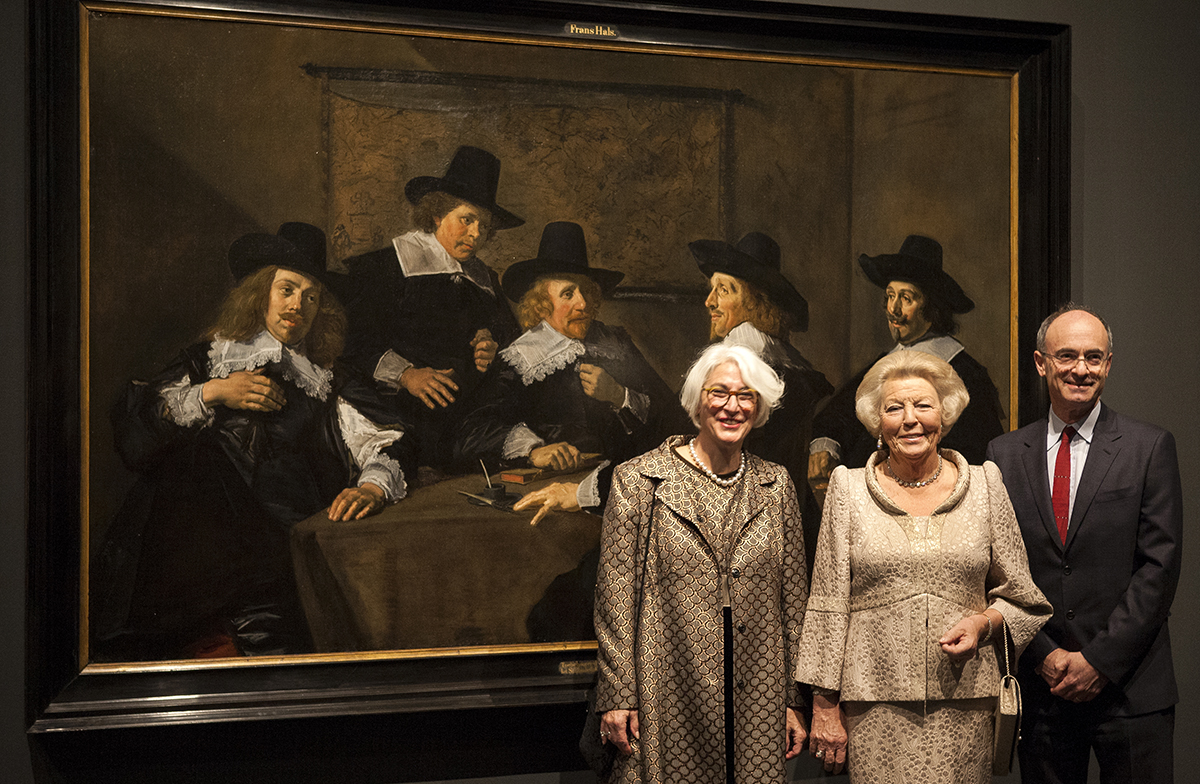Dutch Royalty—in Portraits and Real Life—Visits the MFA for ‘Class Distinctions’

From left: MFA curator Ronni Baer, Her Royal Highness Princess Beatrix of the Netherlands, and museum director Matthew Teitelbaum. / Photo by Olga Khvan
Royalty walked among royalty at the Museum of Fine Arts on Monday evening.
Led by Ronni Baer, the museum’s senior curator of European paintings, and director Matthew Teitelbaum, Her Royal Highness Princess Beatrix of the Netherlands, who reigned as queen from 1980 to 2013, was among the first to examine works featured in the MFA’s major new exhibition of Dutch paintings.
The princess admired works by Dutch masters, including Anthony van Dyck and Michiel van Mierevelt, who had painted portraits of her predecessors—the stadholders, or lieutenants, who ruled the provinces of the Dutch Republic long before a monarchy was established.
Titled “Class Distinctions: Dutch Painting in the Age of Rembrandt and Vermeer,” the exhibition, which Baer spent five years working on, explores depictions of social hierarchy in the 17th-century Dutch Republic. It’s organized thematically into four sections—three that depict the upper, middle, and lower classes, as well as a final section that showcases their intersection.
The exhibition relies on loans from more than 40 institutions throughout the U.S., Canada, and Europe.
“We have many extraordinary lenders, both institutional and individual—the Queen of England is both,” said Teitelbaum at a press preview.
Nearly a third of the 75 paintings featured in the exhibition have never been seen in the U.S. before.

For the first time in MFA history, two works by Vermeer are on display: ‘A Lady Writing’ (left) and ‘The Astronomer’ (right). / Courtesy of the Museum of Fine Arts, Boston
Baer, who joined the MFA in 2000 and curated the popular 2008 exhibition on Spanish painters El Greco and Velasquez, is no stranger to securing rare international loans. Earlier this year, she brought Gustav Klimt’s “Adam and Eve” to the MFA, on loan from the Belvedere Museum in Vienna—it was the first time that the museum had ever displayed a painting by Klimt in its history.
“Class Distinctions” boasts another milestone for the MFA—the first time that two works by Vermeer are on view at the museum at the same time.
In the exhibition, they’re situated within the gallery dedicated to the upper class, offering examples of leisures enjoyed by the elite. One, on loan from the National Gallery of Art, depicts a woman writing a letter—it’s a testament to her literacy, a remarkable skill for a woman in 17th-century Dutch Republic.
“Literacy was not something one took for granted,” said Baer. “This woman knew how to read and write—the fact that she has time and knowledge to do this is why she’s here.”
The second work by Vermeer, “The Astronomer,” on loan from the Louvre, portrays a man—a rare subject in works by the artist—observing a celestial globe.
“He’s a gentleman amateur, not a professional,” said Baer. “He’s a dilettante, and he’s pursuing an intellectual passion that only the very wealthy can afford to do.”
The gallery devoted to the middle class, on the other hand, portrays professionals—the merchants, craftsmen, and tradesmen of Dutch society—as well as their female counterparts, who enjoyed a higher level of independence than elsewhere in Europe. This section features Baer’s favorite painting in the exhibition—”The Shipbuilder and His Wife” by Rembrandt, on loan from the British Royal Collection and displayed in the U.S. for the first time.

‘The Shipbuilder and His Wife’ by Rembrandt is on view in the U.S. for the first time / Courtesy of the Museum of Fine Arts, Boston
A painting of a prostitute, dressed in a way that exceeds her stature, provides a segue into the gallery dedicated to the lower class, whose members toiled for their living. Depictions of hard physical labor were rare in Dutch society, lacking an appeal on the open market, but Baer has included scenic paintings that offer glimpses into the lower class’s workplaces. A glorious seascape by Simon de Vlieger, for example, showcases the scope of the herring fishery industry.
“If you look closely, even the most grand of Dutch pictures has an element of labor in it that this exhibition tries to draw our attention to,” said Baer.
The final room presents situations in which all three classes intersect—in the countryside, on the ice, aboard ferry boats, on the thresholds of businesses and homes.
To further distinguish differences among lifestyles in the society, a table for each class has been set up in this gallery, featuring the same selection of objects—pitchers, candlesticks, eating utensils, linens, and the like—that vary in form, decoration, and material from table to table, class to class.
As visitors step out of the exhibition, they can also step into a large-scale reproduction of Jacob Ochtervelt’s “Street Musicians at the Door” and take photos that they’re then encouraged to post on social media. Additionally, visitors can use a quill pen to address a free postcard featuring Vermeer’s “A Lady Writing.”
“Class Distinctions: Dutch Painting in the Age of Rembrandt and Vermeer” opens to the public on Sunday, October 11, and will remain on view through January 18, 2016. For more information, visit mfa.org.


